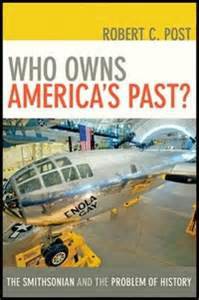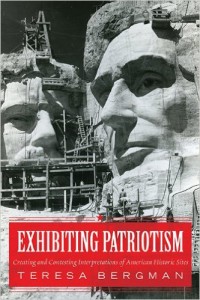For Part One of this review essay, check this link.
Review Essay By Nick Sacco
Robert C. Post, Who Owns America’s Past? The Smithsonian and the Problem of History (The Johns Hopkins University Press, 2013) 370 pages.
Teresa Bergman, Exhibiting Patriotism: Creating and Contesting Interpretations of American Historic Sites (Left Coast Press, 2013) 251 pages.
Whereas Meringolo’s study focuses on both the Smithsonian and the National Park Service, Robert Post’s Who Owns America’s Past focuses exclusively on the Smithsonian and its curatorial practices. Post, a Curator Emeritus with the Smithsonian, weaves institutional history and personal memoir into a narrative of conflict over the appropriate representation of American history within the agency’s museum exhibits.
Analyzing the work of Smithsonian museum curators from the agency’s 1846 founding to the present, Post argues that the desires of Capitol Hill politicians, wealthy donors, and some agency staff to tell a story of unbounded technological progress has created tensions between education and celebration and between commercialism and “public enlightenment.” From Congressman and historian New Gingrich (who complained in the 1990s that “Americans are sick and tired of being told by some cultural elite that they ought to be ashamed of their country”) to Senator Diane Feinstein (who wondered why the Smithsonian had to “interpret history” instead of just giving visitors the facts) to philanthropist Kenneth Behring (who offered to donate $80 million to the National Museum of American History if the Smithsonian would do away with “academically faddish multiculture exhibits” and “really do an American history museum”), lingering concerns about overly provocative exhibits that challenge traditional progress narratives has, according to Post, led to the creation of exhibits that “to this day . . . rarely lack a celebratory tenor” (xiv).
The politics of exhibit interpretation were readily apparent even in 1846. Joseph Henry, the Smithsonian’s first Secretary, took a strong preference to scientific research and scholarship over the dissemination of knowledge to a public audience. A national museum, argued Henry, was “liable to be brought under direct political influence” by public and private parties interested in shaping the Smithsonian’s mission for their own purposes (5-6). Reflective of an interest in presenting “objective” knowledge to museum visitors, curators with mostly professional science backgrounds arranged museum artifacts by shared characteristics and provenance. These items were frequently given short descriptive labels that included dates and identification but little historical context. According to Post, “the Smithsonian’s historical exhibits [were] driven by [artifacts] assumed to be intrinsically interesting and by the assumption that artifacts ‘spoke for  themselves'” (8).
themselves'” (8).
Starting in the 1930s and continuing into the 1970s, Smithsonian curators moved away from collection-based exhibits towards “story-based” interpretations with concrete themes and spaces for reflective contemplation. Curators took a more selective approach in choosing artifacts for public display and collaborated with museum designers when organizing exhibit content. Secretary Sidney Dillon Ripley embraced these efforts and went so far as to state his wish to dispel the “myth that all our ancestors were upper middle-class Protestant whites who lived like ladies and gentlemen” (64). Exhibits during this period explored a range of topics that included labor history, urban poverty, and critical analyses of technological developments in transit, science, and culture. Amid the tensions of the Cold War, however, some museum visitors and even museum staff (such as the historian Daniel J. Boorstin, who rejected calls to design a history exhibit dedicated exclusively to African American history in the early 1970s) resisted the transition from consensus history to critical history. Post cites, for example, one newspaper editorial which complained that “one does not enshrine inventions that failed, or published anthologies of the world’s worst poetry. Let’s concentrate on wiping out the ghettos, not memorializing them” (64). Despite efforts to challenge accepted historical narratives during this period, the Smithsonian continued to walk a fine between representing itself as a shrine to the nostalgic past and a forum for discussing the contentious present. One notable exception to these tensions was the Smithsonian’s Anacostia Community Museum, an urban history museum dedicated to community dialogue, organizing, and outreach that opened in 1967 and which receives scant mention from Post in Who Owns America’s Past?.
Intellectual historians will also find Post’s discussion of the Enola Gay exhibit controversy in the last third of the book to be a useful addition to an already growing historiography of the culture wars.[1] Post argues that the 1980s and 1990s brought about a new understanding from museum practitioners about audience motivations. “The museum audience, whether family vacationers or school children, did not have the same interests or expectations as the audience for scholarly discourse” (190). New interpretive programs and exhibits sought to diffuse knowledge through question-based methods that promoted dialogue and further contemplation beyond the museum’s walls. When Smithsonian curators designed the Enola Gay exhibit to ask questions about the dropping of atomic bombs on Hiroshima and Nagasaki, Japan, in 1945, however, politicians of all stripes infamously decried “historical revisionism” in the exhibit and demanded its removal. The Enola Gay was relocated in 2003 to the Stephen F. Udvar-Hazy Center in Fairfax County, Virginia, with a toned down exhibit label that merely included factual information about the technical specifications of the plane. Stripped of its historical context, human agency, and deadly impact, Post argues that the Enola Gay‘s current exhibit display reflects a milquetoast desire to give people “the facts” to make up their own minds without providing the causes, context, and consequences of its history.
Other historic sites have struggled to transition from collections-based institutions focused on research to visitor-centered ones that value education. Teresa Bergman explores five such sites in Exhibiting Patriotism in an effort to provide public historians with case studies for exploring the ways multiple publics have demanded the inclusion of their stories into cultural sites that interpret United States history. Bergman, a Communications and Film Studies professor at the University of the Pacific, uses five chapters to describe the evolution of historical interpretation at the U.S.S. Arizona Memorial Visitor Center, the California Railroad Museum, the Alamo, the Lincoln Memorial, and Mount Rushmore.
Bergman’s most insightful commentary comes from her discussions of orientation films at cultural sites, which “function as an introduction and an invitation to learn about a significant site and its meaning” (151). She shows how visitors construct historical meaning through film and how this medium is politicized in ways similar to museum exhibits or interpretive programs. The initial orientation film at the U.S.S. Arizona, for example, was decried by U.S. World War II veterans in the 1980s for being “too soft” on the Japanese. In an effort to address these concerns, the National Park Service’s revised  1992 film focused more on the honor of Pearl Harbor soldiers and portrayed the U.S.S. Arizona Memorial as a shrine to their sacrifices. Yet this film also made interpretive errors by suggesting that there were Hawai’ian Japanese residents who spied for the Japanese government and showing provocative newspaper headlines from 1941 with racist imagery and headlines. Complaints from the Hawai’ian Japanese community prompted NPS leadership to consult with academic historians, all of whom criticized the film for downplaying America’s own imperialist ambitions and for never mentioning the high number of Asian Americans who fought for the United States military after Pearl Harbor. Bergman concludes that these debates over the U.S.S. Arizona orientation film stand “as a case in point of the tremendously consequential and fluid nature of public historic sites and an exemplar of a local community’s ability to affect change in the construction of public memory” (58).
1992 film focused more on the honor of Pearl Harbor soldiers and portrayed the U.S.S. Arizona Memorial as a shrine to their sacrifices. Yet this film also made interpretive errors by suggesting that there were Hawai’ian Japanese residents who spied for the Japanese government and showing provocative newspaper headlines from 1941 with racist imagery and headlines. Complaints from the Hawai’ian Japanese community prompted NPS leadership to consult with academic historians, all of whom criticized the film for downplaying America’s own imperialist ambitions and for never mentioning the high number of Asian Americans who fought for the United States military after Pearl Harbor. Bergman concludes that these debates over the U.S.S. Arizona orientation film stand “as a case in point of the tremendously consequential and fluid nature of public historic sites and an exemplar of a local community’s ability to affect change in the construction of public memory” (58).
Similar sites have also wrestled with the implications of their orientation films. At Mount Rushmore three different orientation films have successfully portrayed a hagiographic representation of Gutzon Borglum (the monument’s creator), the choice of the four presidents who adorn the monument, and the current film’s portrayal of a “celebratory and [progressive] vision of U.S. history without depictions of economic exploitation, Civil War deaths, slavery, or Washingtonian regrets,” according to Bergman (162), and challenges still remain in thoughtfully incorporating Native American history into the site. Meanwhile, the Lincoln Memorial’s orientation film receives praise from Bergman for acknowledging and celebrating the monument’s contented space as a protest site for civil rights activism. While I agree with Sarah J. Purcell that Bergman’s analysis of how historic sites create nationalism and patriotism is “fuzzy,” her analysis of the intersection of film and public history is a must-read for intellectual historians, public historians, and documentary film editors.[2]
***
Each of these studies illuminates the fluidity of public history practices and the ongoing challenges of interpreting inclusive, accurate stories for many audiences and identities. The historiography of public history in recent years has relevance to intellectual history in that both share an interest in understanding how the cultural conditions of a given time period shape the ideas and arguments that underlie historical narratives and memories in public spaces. Public history scholarship argues that understanding the past requires expanding our inquires beyond textual sources towards uncovering the contested meanings of material artifacts and historical landscapes, both natural and built. This scholarship also challenges us to analyze and criticize other mediums besides books in which historical knowledge is communicated, including museum exhibits, interpretive tours, films, music, and radio. In expanding the scope of content and methods worthy of historical inquiry, public and intellectual historians can lead the discipline towards a more inclusive approach towards understanding the ways history shapes our world.
[1] Andrew Hartman, “A Boom Year in Culture Wars Historiography,” Society of U.S. Intellectual History, January 21, 2015. Accessed April 25, 2015. https://s-usih.org/2015/01/a-boom-year-in-culture-wars-historiography.html
[2] Sarah J. Purcell, review of Teresa Bergman, Exhibiting Patriotism: Creating and Contesting Interpretations of American Historic Sites (Walnut Creek, CA: Left Coast Press, 2013), The Public Historian 36, no. 4 (November 2014), 94-95.
Nick Sacco is a public historian and Park Guide with the Natio nal Park Service at the Ulysses S. Grant National Historic Site in St. Louis, Missouri. In May 2014, he received his Master’s degree in history from Indiana University – Purdue University Indianapolis (IUPUI) and recently published a journal article on the Grand Army of the Republic and Civil War Memory.
nal Park Service at the Ulysses S. Grant National Historic Site in St. Louis, Missouri. In May 2014, he received his Master’s degree in history from Indiana University – Purdue University Indianapolis (IUPUI) and recently published a journal article on the Grand Army of the Republic and Civil War Memory.

0